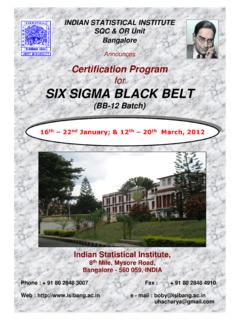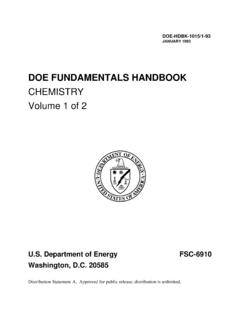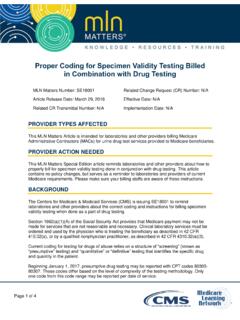Transcription of Engineering Handbook
1 1 Engineering HANDBOOKSTEELMAKINGB asic descriptions of making carbon, alloy, stainless, and tool steel p. & ALLOYSC arbon grades, types, and numbering systems; glossary p. CONTENTI dentification factors and composition standards p. TREATMENTQ uenching, hardening, and other thermal modifications p. THE HARDNESS OF METALST ypes and comparisons; glossary p. PROPERTIES OF METALC omparisons of ductility, stresses; glossary Huyett s distinct capabilities; glossary p. , PLATING & THE COLORING OF METALSF inishes p. CHARTSI mperial and metric p. document and the informationcontained herein is not a design standard, design guide or otherwise, but is here solely for the convenience of our customers. For more design assistance contact our plant or consult the Machinery Handbook , published by Industrial Press Inc.
2 , New 232, Exit 49 Huyett Expy Minneapolis, KS 67467 TABLE OF CONTENTSI ntroduction3 Steelmaking4 Metals and Alloys13 Designations for Chemical Content27 Designations for Heat Treatment30 Testing the Hardness of Metals34 Mechanical Properties of Metal41 Manufacturing Processes53 Manufacturing Glossary57 Conversion Coating, Plating, and the Coloring of Metals 81 Conversion Charts84 Links and Related Sites89 Index90 Box 232 Exit 49 Huyett Expressway Minneapolis, Kansas 67467785-392-3017 Fax 785-392-2845 document was created based on research and experience of Huyett technical information, including statistical data contained in the tables, is from the 26thEdition Machinery Handbook , copyrighted and published in 2000 by Industrial Press, Inc.
3 Of New York, making information and flowcharts were produced with information from the website of TheAmerican Iron and Steel Institute (AISI) 1140 Connecticut Ave., NW, Suite 705 Washington, technical definitions are from Everything You Always Wanted to Know About Steel.. AGlossary of Terms and Concepts, Summer 1998 Courtesy of Michelle Applebaum, Managing 2000, Salomon Smith Barney glossary definitions are taken from Cutting Tool Engineering (ISSN:0011-4189) Copyright byCTE Publications Inc. 107 W. Van Buren, Ste. 204, Chicago, IL regarding differences of steel grades and their properties came from the McMaster-CarrSupply Company website at , copyright 2003 by the McMaster-Carr basic and helpful information about steel properties and usage came from Metallurgy FAQ Copyright 1999 Drake H.
4 Damerau, All rights reserved, at Survivalist document is provided to customers, vendors, and associates of Huyett for technical informationrelating to the manufacture and sale of non-threaded industrial fasteners. As such, this document isnot a design standard, design guide, or otherwise. Huyett in not engaged in part and productdesign, because of the unknown uses of parts made or distributed by the company. Designs must beproduced and tested by our customers for individual and commercial such, Huyett assumes no liability of any kind, implied or expressed, for the accuracy, scope, andcompletion of the information & ACKNOWLEDGMENTS Huyett 20044 Steel is the generic term for a large family of iron carbon alloys, which are malleable, within sometemperature range, immediately after solidification from the molten state.
5 The principal rawmaterials used in steelmaking are iron ore, coal, and limestone. These materials are converted in ablast furnace into a product known as pig iron, which contains considerable amounts of carbon(above ), manganese, sulfur, phosphorus, and silicon. Pig iron is hard, brittle, and unsuitablefor direct processing into wrought forms. Pig iron was named long ago when molten iron waspoured through a trench in the ground to flow into shallow earthen holes. The arrangementlooked like newborn pigs suckling. The central channel became known as the sow, and themolds were pigs. Steelmaking is the process of refining pig iron as well as iron and steel scrap by removing undesirableelements from the melt and then adding desirable elements in predetermined amounts.
6 A primaryreaction in most steelmaking is the combination of carbon with oxygen to form a gas. If dissolvedoxygen is not removed from the melt prior to or during pouring, the gaseous products continue toevolve during solidification. If the steel is strongly deoxidized by the addition of deoxidizingelements, no gas is evolved, and the steel is called killed because it lies quietly in the degrees of gas evolution (decreased deoxidation) characterize steels called semikilled , capped, or rimmed. The degree of deoxidation affects some of the properties of the steel. Inaddition to oxygen, liquid steel contains measurable amounts of dissolved hydrogen and some critical steel applications, special deoxidation practices as well as vacuum treatments maybe used to reduce and control dissolved carbon content of common steel grades ranges from a few hundredths of a percent to about1 per cent.
7 All steels also contain varying amounts of other elements, principally manganese, whichacts as a deoxidizer and facilitates hot working. Silicon, phosphorus, and sulfur are also alwayspresent, if only in trace amounts. Other elements may be present, either as residuals that are notintentionally added, but result from the raw materials or steelmaking practice, or as alloyingelements added to effect changes in the properties of the steel. When reviewing a steel chemicalcertification, remember that iron is the element that composes the majority of the chemical valueslisted. (See Exhibit I attached)Steels can be cast to shape, or the cast ingot or strand can be reheated and hot worked by rolling,forging, extrusion, or other processes into a wrought mill shape.
8 Wrought steels are the mostwidely used of Engineering materials, offering a multitude of forms, finishes, strengths, and usabletemperature ranges. No other material offers comparable versatility for product hot working, steel goes through a pickling process. Pickling is a chemical processwhereby steel is run through a progressive series of tanks. Chemicals in the tanks remove oxidationand impurities from the surface of the product. Hydrochloric acid is a common chemical compoundused in steel, typical of the grades used in Huyett s manufacturing, are cold rolled (or colddrawn) after being pickled. Cold finishing, as the process is generally referred to, involves runningthe hot rolled pickled and oil product through a series of progressive dies or rollers at roomtemperature.
9 The effect of such work stretches the steel, which creates a permanent increase inthe hardness, strength, and finish of the finished steel is typically ready to be used for manufacturing finished goods, but in somecases, additional processes are performed. For Huyett keystock, bars are bead blasted tocreate a bright steel that is free of surface imperfections that could cause problems when insertedin a Huyett 20045 Other grades such as Blue tempered (also known as Blue Clock, ) which is used to manufactureshims, are heat treated and ground for finer tolerances and hardened must be handled carefully after manufacturing so that straightness tolerances are maintainedand surface imperfections are not created. Proper storage from the elements must be used (includingwhen shipping on a truck) to minimize corrosion.
10 Finally, steel must be handled carefully duringloading and unloading so that bars are not bent, warped, or pinged on the sides. Particularly forkeystock, it is important that edges be sharp, straight, and true to ease installation into the keyway. Huyett 20046 AGEHJIFDBCAGEHJIFDBCT olerance Describes the accountable manufacturing Authority Describes the organization that created the specification (AISI is the American Iron and Steel Institute).Grade Specifically refers to chemical content and physical Source Denotes actual mill where iron was Number The special lot or melt from which the product was Analysis Lists the content values of various elements expressed as a share of one percent (ex..30 of carbon=.003).Tensile Strength Also called ultimate strength, measurement at which steel exhibits Strength Related to tensile, yield is the stress level at which steel exhibits Properties Represents values determined by physically testing the Elongation is the increase in gage length or pull when steel is tensile that chemi-cal values do nottotal 100%.












